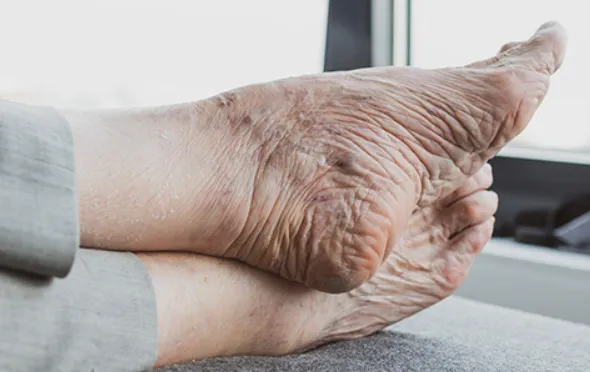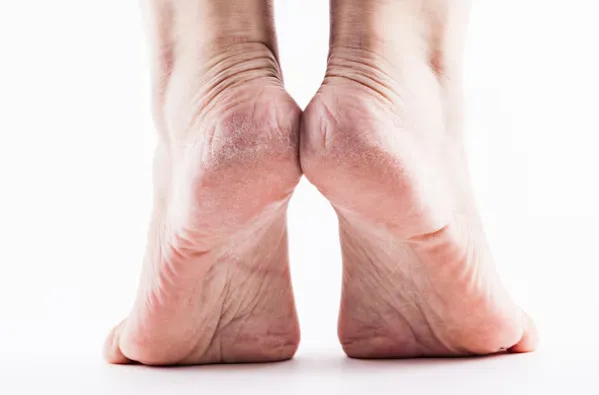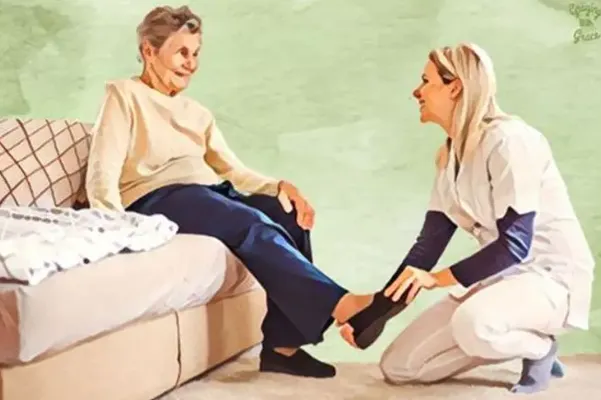Aging Feet vs. Foot Problems: When to See a Podiatrist
Aging Feet vs. Foot Problems: When to See a Podiatrist
Here's a critical distinction that could save you years of frustration: not all foot discomfort is a "problem" that needs fixing. Some changes are normal aging that requires adaptation, while others are genuine pathologies that respond to treatment. Knowing the difference could transform your approach to foot health.

The Great Misconception: Normal Aging vs. Disease
One of the biggest mistakes people make with foot health is assuming that all age-related changes are problems to be "cured" rather than natural adaptations to be managed intelligently.
This misconception leads to:
- ❌ Wasted money on products that can't reverse natural aging
- ❌ Unrealistic expectations about what treatments can accomplish
- ❌ Missed opportunities to address actual treatable conditions
- ❌ Delayed professional care for problems that really do need medical attention
The key to smart foot health after 40 is learning to distinguish between what can be changed and what must be accommodated.
🎯 The Wisdom Approach: Instead of fighting every age-related change, focus your energy on the problems that actually respond to intervention while gracefully adapting to the ones that don't.
Normal Aging: What You Can't (and Shouldn't Try to) Reverse

Let's start with the changes that are completely normal, predictable, and irreversible—but that marketing often tries to convince you are "fixable."
Fat Pad Atrophy: The Natural Cushion Loss
What Happens: As we age, the fibro-fatty pads that cushion the bottom of our feet—particularly under the heel and ball of the foot—naturally thin out and lose their shock-absorbing capacity.
Why It Happens: This is a universal aging process, similar to how facial fat pads thin over time. The specialized fat in your feet is designed to be highly resilient, but decades of use and natural aging take their toll.
The Reality:
- ✅ This is completely normal—it happens to virtually everyone
- ❌ It cannot be reversed by exercises, toe spacers, or supplements
- 🛠️ It can be managed with appropriate footwear and cushioning
Smart Management:
- Well-cushioned shoes with good shock absorption
- Quality insoles designed for impact protection
- In severe cases, medical procedures like filler injections (under professional care)
- Avoiding high-impact activities on hard surfaces
💡 Reframe It: Fat pad atrophy isn't a failure of your feet—it's evidence that they've carried you faithfully for decades. Honor that service with appropriate support.
Loss of Tissue Elasticity: The Flexibility Factor
What Happens: Ligaments and tendons throughout your body, including those in your feet, naturally lose elasticity and tensile strength over time.
The Foot-Specific Effects:
- Gradual stretching and weakening of arch-supporting structures
- "Falling" or lowering of the longitudinal arch (adult-acquired flat foot)
- General widening and lengthening of the entire foot
- Reduced joint mobility and flexibility
Why Your Shoe Size Changes: This is why many people need to go up a half or full shoe size as they get older. Your feet aren't "growing"—they're settling into a more relaxed, less supported position.
The Management Approach:
- Accept that your foot shape and size may change
- Regularly reassess your shoe fit (especially width)
- Consider supportive insoles for comfort and function
- Maintain what mobility you can through gentle stretching
👟 Shopping Reality: That larger shoe size isn't a sign of "foot problems"—it's a sign of normal structural changes that require accommodation, not correction.
Skin and Nail Changes: The Surface Story
Normal Age-Related Changes:
- Skin: Becomes thinner, drier, and more fragile
- Nails: Often become thicker, more brittle, and harder to manage
- Healing: Generally slower than in younger years
- Sensation: May gradually decrease, especially in extremities
The Practical Impact:
- Higher risk of cuts and skin tears
- Increased susceptibility to fungal infections
- Need for more careful foot hygiene and inspection
- May require professional help for nail care
Smart Adaptation:
- Daily moisturizing with appropriate foot creams
- Gentle nail care techniques or professional services
- Regular foot inspection for early problem detection
- Protective footwear to prevent injuries
Real Problems vs. Normal Aging: Making the Distinction
Now let's talk about the changes that aren't normal aging and do warrant attention and potential treatment.
Pathological Conditions That Respond to Treatment
Bunions and Hammertoes:
- While more common with age, these are specific deformities, not inevitable aging
- Can be caused by years of poor footwear choices
- May respond to conservative treatment (exercises, spacers, proper shoes)
- In severe cases, surgical correction is possible
Plantar Fasciitis:
- Not a normal part of aging
- Specific condition involving inflammation/degeneration of plantar tissue
- Has identifiable causes and evidence-based treatments
- Can often be successfully managed or resolved
Arthritis:
- While joint wear is age-related, significant pain and limitation aren't inevitable
- Various types respond to different treatments
- Professional evaluation can distinguish between types and severity
- Many management options available
Nerve Compression (Morton's Neuroma, etc.):
- Specific pathological conditions, not normal aging
- Have identifiable symptoms and treatment options
- Can often be successfully managed conservatively
🔍 The Key Difference: Pathological conditions have specific symptoms, identifiable causes, and potential treatments. Normal aging involves gradual, universal changes that require adaptation rather than cure.
Your Decision Tree: Self-Care vs. Professional Help

Here's your practical guide to knowing when you can manage things yourself versus when you need professional evaluation.
✅ Self-Management May Be Appropriate For:
Mild, Occasional Issues:
- Minor foot fatigue that resolves with rest
- Temporary aches that improve with better shoes
- Mild stiffness that responds to gentle stretching
- General comfort issues in specific shoes
Normal Aging Accommodations:
- Gradual changes in foot size or shape
- Need for more cushioning or support
- Minor changes in flexibility or strength
- Preventive care and maintenance
Response to Conservative Measures:
- Problems that improve with rest, ice, or stretching
- Issues that resolve with better footwear
- Temporary discomfort that doesn't worsen over time
🏠 Self-Care Success: If simple, logical interventions provide meaningful improvement, you're likely dealing with something manageable at home.
🚨 Professional Consultation Required For:
Persistent Pain:
- Foot, ankle, or heel pain lasting more than 2-3 weeks
- Pain that doesn't improve with rest and basic measures
- Pain that interferes with normal activities
- Important: Foot pain is not a normal part of aging
Neurological Symptoms:
- Any numbness, tingling, or burning sensations
- Changes in sensation (hot, cold, pressure)
- "Pins and needles" feelings
- These can indicate nerve damage or compression
Signs of Inflammation or Infection:
- Persistent swelling in one foot
- Redness, warmth, or tenderness
- Any discharge or open wounds
- Fever associated with foot symptoms
Structural Changes:
- Visible development or worsening of deformities
- One foot suddenly appearing different from the other
- New bumps, lumps, or prominent areas
- Rapid changes in foot shape or alignment
Functional Limitations:
- Difficulty walking, standing, or exercising due to foot problems
- Balance problems related to foot discomfort
- Inability to wear normal shoes due to foot pain
- Limitations in daily activities
High-Risk Medical Conditions:
- Diabetes (regular preventive exams even without symptoms)
- Peripheral vascular disease
- Rheumatoid arthritis or other inflammatory conditions
- Any condition affecting circulation or healing
For comprehensive safety guidelines for high-risk conditions, see our critical safety guide.
👩⚕️ Professional Advantage: A podiatrist doesn't just treat problems—they can distinguish between normal aging and treatable pathologies, potentially saving you years of unnecessary worry or inappropriate self-treatment.
What to Expect from a Podiatric Evaluation
Understanding what happens during a professional foot evaluation can help you prepare and maximize the benefit of your visit.
The Comprehensive Assessment Process
Medical History Review:
- Discussion of your symptoms, duration, and progression
- Review of relevant medical conditions and medications
- Assessment of activity levels and functional limitations
- Family history of foot problems
Physical Examination:
- Evaluation of foot structure and alignment
- Assessment of joint range of motion and flexibility
- Circulation and sensation testing
- Gait analysis (how you walk)
- Muscle strength and balance evaluation
Diagnostic Testing (When Indicated):
- X-rays: For bone and joint problems
- CT scans or MRI: For complex structural issues
- Ultrasound: For soft tissue problems
- Nerve conduction studies: For neurological symptoms
The Diagnostic Value: Why Professional Assessment Matters
Here's the fundamental value of professional evaluation: a layperson experiencing "foot pain" cannot know its true cause.
The same symptom (foot pain) could indicate:
- ✅ Simple biomechanical issue from poor shoes → Easy fix with proper footwear
- ⚠️ Progressive structural deformity → May benefit from conservative treatment or surgery
- 🟡 Irreversible age-related change → Requires adaptation and management strategies
- 🚨 Limb-threatening circulation problem → Requires immediate medical intervention
Each possibility requires a completely different approach:
- Using toe spacers for fat pad atrophy would be useless
- Ignoring circulation problems could be devastating
- Trying to "cure" normal aging leads to frustration and wasted resources
- Missing a treatable condition means unnecessary suffering
🎯 The Critical Point: The most important step for any persistent foot problem isn't choosing a treatment—it's getting an accurate diagnosis.
Treatment Planning: From Diagnosis to Action
Based on the evaluation, your podiatrist can develop a personalized treatment plan that might include:
Conservative Interventions:
- Specific footwear recommendations
- Custom orthotic prescription and fitting
- Targeted exercise programs or physical therapy referrals
- Appropriate use of over-the-counter devices (including toe spacers)
For guidance on building a comprehensive approach, see our complete foot health program guide.
Medical Treatments:
- Injection therapies for specific conditions
- Prescription medications for inflammatory conditions
- Wound care for diabetic or circulation-related issues
Surgical Options:
- When conservative measures aren't sufficient
- For severe deformities causing significant functional limitation
- Timing considerations and realistic outcome expectations
Ongoing Management:
- Follow-up schedules based on your specific needs
- Monitoring of progressive conditions
- Adjustment of treatments based on response
The Professional Consultation Decision Framework

Still unsure whether you need professional help? Use this decision framework:
Immediate Consultation (Don't Wait)
- Any open wound or non-healing injury
- Signs of infection (redness, warmth, swelling, discharge)
- Sudden onset of severe pain
- Complete loss of sensation in any area
- Diabetes with any foot changes or concerns
Prompt Consultation (Within 1-2 Weeks)
- Pain persisting more than 2-3 weeks
- Progressive worsening of symptoms
- Functional limitations affecting daily life
- New onset of neurological symptoms
- Visible structural changes
Planned Consultation (When Convenient)
- Chronic issues that are stable but bothersome
- Preventive evaluation for high-risk conditions
- Optimization of current management strategies
- Second opinion on treatment recommendations
Consider Self-Management First
- Minor, occasional discomfort
- Issues clearly related to specific shoes or activities
- Problems that respond well to basic measures
- Normal aging changes without pain or limitation
⏰ Timing Strategy: When in doubt, err on the side of earlier rather than later consultation. Early intervention often prevents more complex problems down the road.
Reframing the Professional Relationship
Many people view going to a podiatrist as admitting defeat or acknowledging that their feet are "broken." This mindset is counterproductive.
A Better Perspective: Partnership for Optimal Function
Think of your podiatrist as:
- 🎯 A diagnostic expert who can distinguish between different types of foot problems
- 🛠️ A treatment strategist who knows which interventions work for which conditions
- 👩⚕️ A prevention specialist who can help you avoid future problems
- 🔄 A long-term partner in maintaining mobility and function as you age
Not as:
- ❌ Someone you only see when everything else has failed
- ❌ A last resort before accepting foot problems as inevitable
- ❌ An admission that you can't manage your own health
🤝 Partnership Approach: The best outcomes often come from combining professional expertise with consistent self-care—not from trying to do everything yourself or relying entirely on others.
The Bottom Line: Wisdom in Foot Health
Smart foot health after 40 requires a fundamental shift in perspective:
Instead of: "How do I fix every foot problem?" Ask: "Which changes can I influence, and which do I need to adapt to?"
Instead of: "Are my feet broken?" Ask: "How can I optimize function within my current reality?"
Instead of: "Should I try to avoid the doctor?" Ask: "How can professional expertise help me make better decisions?"
The goal isn't to have the feet of a 20-year-old—it's to have the best possible function and comfort given your current age, health status, and lifestyle needs.
🎯 The Wisdom Approach: Successful aging involves knowing when to fight, when to adapt, and when to seek help. This principle applies to feet just as much as any other aspect of health.
Next up: Our final article will tie everything together—giving you a complete, evidence-based roadmap for lifelong foot health that puts toe spacers in proper perspective within a comprehensive approach.
Professional Guidance Note: This information helps you make informed decisions about when to seek professional care, but it doesn't replace actual medical evaluation. When in doubt about any foot symptom or condition, consulting with a podiatrist provides the most accurate assessment and appropriate treatment recommendations.
Comments
Post a Comment